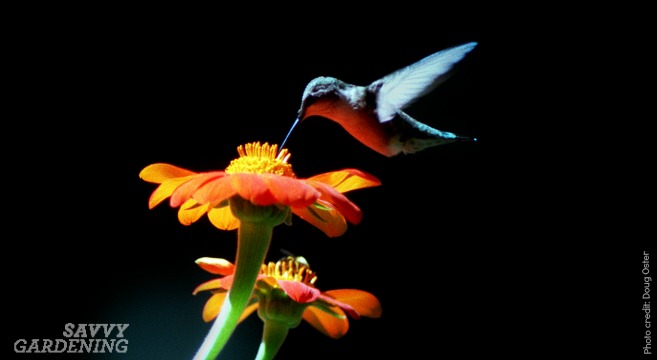This post may contain affiliate links. If you make a purchase through links on our site, we may earn a commission.
Though summer may seem a long way off, now is the perfect time to be thinking about what kind of visitors you’d like to welcome to your garden. While human friends and family are a sure bet, wildlife is not. But by selecting and planting the “right” plants, you can influence what creatures will make a home in your garden over the coming months. Attracting hummingbirds, bees, butterflies, toads, salamanders, songbirds, and other fascinating garden guests doesn’t mean putting out a welcome mat; what they need instead is the appropriate habitat and a diversity of plants capable of supporting them.
Hummingbird Visitors
Today, I’d like to talk about attracting the most admired of all garden visitors – the hummingbird. I garden in Pennsylvania, and because ruby-throated hummingbirds breed here, they are the most common species. I have, however, heard of the occasional gardener in our region being blessed with a late-season sighting of a rufous hummer, a migrating western species that sometimes veers off-course when moving from its breeding grounds in the Pacific Northwest to its winter home in Mexico. There are other species that are spotted occasionally as well, including the calliope hummer and Allen’s hummer, but sightings of those species are few and far between where I live.
Aside from their antics in the garden, one of my favorite things about these beautiful little birds is their tendency to return to the same yard year after year. We had a mating pair reside in our backyard for three years in a row. It was very exciting to spot them at the start of each new season, and I’m curious to see if they return again this year.
Here are a few things you can do to encourage these amazing feathered jewels, no matter which species share your corner of the earth.
4 Steps for Attracting Hummingbirds to Your Landscape
1. Install feeders: For attracting hummingbirds in most parts of North America, backyard nectar feeders should be filled by early April to support nest-building efforts. I look for feeders like this one that are easy to wash and have more than one nectar funnel. Wash and refill the feeder every week to prevent bacteria from building up inside. You can invest in commercially-made food mixtures or simply make your own by boiling 1 cup of organic granulated sugar in 4 cups of water for two minutes. Let it cool and then fill the feeder. You can keep the excess sugar water in the fridge for a week or two.
2. Plant: Incorporate as many different hummingbird-friendly, flowering plants in your garden as possible. Hummers are highly attracted to the color red and to long, tubular flowers, so be sure to include plenty of them in your landscape each season.
Here’s a list of a few of my favorite plants for attracting hummingbirds:
- Trees and Shrubs: weigela, red buckeye, native honeysuckles, horse chestnut, catalpa, azalea, flowering quince
- Perennials: agastache, columbine, cardinal flower, penstemon, monarda, coral bells, red hot pokers, foxglove
- Annuals: lantana, fuchsia, petunias, pineapple sage, tithonia, salvia
- Vines: cypress vine, scarlet runner bean, morning glories
3. Eliminate pesticides: Hummingbirds also consume small insects as part of their diet. Having pesticides in the garden’s food chain is detrimental to many other species of insectivorous birds as well.
4. Create habitat: Female hummingbirds select a nesting location based on its distance from predators, its integrity, and its shelter from rain, sun, and high winds. Often located at the fork of a branch at least ten feet above the ground, hummingbird nests are very small. Females are the nest builders, using pieces of moss, lichens, lint, spider webs, small twigs, seed stalks, plant “down”, and other materials to form the nest and then molding it into the proper shape with their small bodies.
It will take about a week to make the inch-wide nest. To encourage nesting, include plants that produce quality nesting materials in your landscape. Willows, cottonwood, and birch grow soft catkins to line nests, and clematis, milkweed, goldenrod, thistles, and pasque flowers produce tufts of silky fibers that are a choice nest-building material for hummers. You can also hang nesting materials like these up for the birds to use. Attracting hummingbirds means having plenty of nest-building materials around.

Do hummingbirds find a home in your garden? We’d love to hear about it in the comments below.
Pin it!




Thanks for the great hummingbird article! Here on our western Washington farm we have both Rufous and Anna’s hummingbirds, and I love feeding and watching them through the year (our Anna’s hummers actually spend the winter!). One of their favorite food plants here is native red flowering currant.
The year I planted tithonia I had multiple hummingbirds and monarchs. I started from seedin March but probably could have started even earlier.
I am one of the lucky ones to have a Rufous female visiting my central pa backyard since October. She was banded Nov 26th and we have been keeping the feeder warm for her. Hopefully she will stay and return next year and I will also be planning a more robust garden for her if she returns.
Pulmonaria or William and Mary is the first flower blooming that attracts hummingbirds here near Pugwash, NS.